Hepatitis B virus multi-locus genotypic resistance mutation detection method
A virus, whole gene technology, applied in the field of hepatitis B virus multi-locus gene resistance mutation detection, can solve the problems of increasing the chance of PCR amplification product contamination, difficult multi-locus gene mutation detection, unsuitable simultaneous detection, etc. To achieve the effect of improving specificity, high sensitivity and eliminating influence
- Summary
- Abstract
- Description
- Claims
- Application Information
AI Technical Summary
Problems solved by technology
Method used
Image
Examples
Embodiment 1
[0044] Embodiment 1 Single-tube nested PCR technology amplifies the whole gene sequence of hepatitis B virus reverse transcriptase
[0045] Design of amplification primers: 729 full-length HBV genome sequences were selected from GenBank, including 209 sequences of Chinese-specific genotypes B and C, and the conserved sequences of the upstream and downstream of the HBV reverse transcriptase gene were compared and analyzed with NTI software. Two rounds of PCR primers were designed as follows: the PCR product was 1225bp, including the full-length 1032bp HBV reverse transcriptase region (nucleotides 130-1161). The second-round primers also serve as sequencing primers.
[0046] SEQ ID NO: 1-4 respectively correspond to the upstream and downstream of the outer primer and the upstream and downstream of the inner primer, see Table 1.
[0047] Table 1 Internal and external primers and positions designed to amplify the whole gene of HBV reverse transcriptase
[0048]
[0049] The e...
Embodiment 2
[0086] Example 2 Single-tube nested PCR gene amplification method to detect hepatitis B virus drug-resistant mutation sites
PUM
| Property | Measurement | Unit |
|---|---|---|
| Sensitivity | aaaaa | aaaaa |
Abstract
Description
Claims
Application Information
 Login to View More
Login to View More - R&D
- Intellectual Property
- Life Sciences
- Materials
- Tech Scout
- Unparalleled Data Quality
- Higher Quality Content
- 60% Fewer Hallucinations
Browse by: Latest US Patents, China's latest patents, Technical Efficacy Thesaurus, Application Domain, Technology Topic, Popular Technical Reports.
© 2025 PatSnap. All rights reserved.Legal|Privacy policy|Modern Slavery Act Transparency Statement|Sitemap|About US| Contact US: help@patsnap.com



